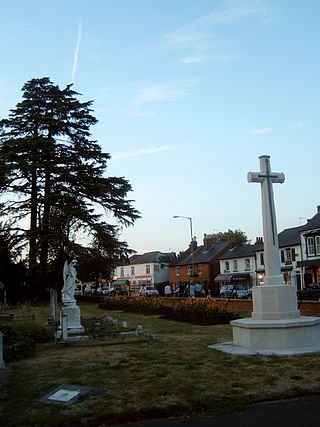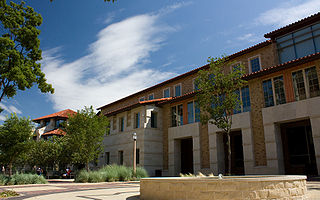
Uxbridge is a suburban town in west London, England, and the administrative headquarters of the London Borough of Hillingdon, 15.4 miles (24.8 km) northwest of Charing Cross. Uxbridge formed part of the parish of Hillingdon in the county of Middlesex. As part of the suburban growth of London in the 20th century it expanded and increased in population, becoming a municipal borough in 1955, and part of Greater London in 1965.

Brunel University of London (BUL) is a public research university located in the Uxbridge area of London, England. It is named after Isambard Kingdom Brunel, a Victorian engineer and pioneer of the Industrial Revolution. It became a university in June 1966, when Brunel College of Advanced Technology was awarded a royal charter and became Brunel University; it is sometimes considered a plate glass university.

The University of Leeds is a public research university in Leeds, West Yorkshire, England. It was established in 1874 as the Yorkshire College of Science. In 1884, it merged with the Leeds School of Medicine and was renamed Yorkshire College. It became part of the federal Victoria University in 1887, joining Owens College and University College Liverpool. In 1904, a royal charter was granted to the University of Leeds by King Edward VII.

Sir Denys Louis Lasdun, CH, CBE, RA was an eminent English architect, the son of Nathan Lasdun (1879–1920) and Julie. Probably his best known work is the Royal National Theatre, on London's South Bank of the Thames, which is a Grade II* listed building and one of the most notable examples of Brutalist design in the United Kingdom.
Brutalist architecture is an architectural style that emerged during the 1950s in the United Kingdom, among the reconstruction projects of the post-war era. Brutalist buildings are characterised by minimalist constructions that showcase the bare building materials and structural elements over decorative design. The style commonly makes use of exposed, unpainted concrete or brick, angular geometric shapes and a predominantly monochrome colour palette; other materials, such as steel, timber, and glass, are also featured.

A campus university is a British term for a university situated on one site, with student accommodation, teaching and research facilities, and leisure activities all together. It is derived from the Latin term campus, meaning "a flat expanse of land, plain, field".

Englefield Green is a large village in the Borough of Runnymede, Surrey, England, approximately 20 miles (32 km) west of central London. It is home to Runnymede Meadow, The Commonwealth Air Forces Memorial, The Savill Garden,and Royal Holloway, University of London.

A student center is a type of building found on university and some high school campuses. In the United States, such a building may also be called a student union, student commons, or union. The term "student union" refers most often in the United States to a building, while in other nations a "students' union" is the student government. Nevertheless, the Association of College Unions International has several hundred campus organizational members in the US; there is no sharp dichotomy in interpretation of union in this context. The US usage in reference to a location is simply a shortened form of student union building.

Uttley House, is a Grade II listed building and halls of residence in Fallowfield, Manchester, England. It was designed and built in 1850 by Edward Walters, who was also responsible for Manchester's Free Trade Hall. The building is named after English writer Alison Uttley. It was originally built for Sir Joseph Whitworth; the house was later the home of C. P. Scott, editor of the Manchester Guardian. It is surrounded by 5.5 acres (2.2 ha) of gardens to the south and an environmental research institute to the north. The house has seen many past uses, including a private home, hotel, vaccination clinic and conference centre.

The Renold Building is a university building in Manchester. It was opened on 23 November 1962 for the Manchester College of Science and Technology as part of a major expansion of its campus in the 1960s. The architect was W.A.Gibbon of the firm of Cruickshank and Seward. The foundation stone was laid on 24 June 1960 by Sir Charles Renold J.P. LL.D (1883–1967), Vice President of the college, and chairman of the planning and development committee, after whom it was named. The main contractor was J. Gerrard & Sons Ltd of Swinton.
The University of Nottingham operates from four campuses in Nottinghamshire and from two overseas campuses, one in Ningbo, China and the other in Semenyih, Malaysia. The Ningbo campus was officially opened on 23 February 2005 by the then British Deputy Prime Minister, John Prescott, in the presence of Chinese education minister Zhou Ji and State Counsellor Chen Zhili. The Malaysia campus was the first purpose-built UK university campus in a foreign country and was officially opened by Najib Tun Razak on 26 September 2005. Najib Tun Razak, as well as being a Nottingham alumnus, was Deputy Prime Minister of Malaysia at the time and has since become Prime Minister of Malaysia.

South Devon College is a further education college with 9 different campuses within Torbay and the surrounding area. The college is part of The University of Plymouth Colleges network.

Uxbridge College is a large general further education college in the London Borough of Hillingdon. In 2017 the college has been merged with Harrow College and in 2023, Richmond upon Thames College became the latest member of the group as they merged to form Harrow, Richmond & Uxbridge College (HRUC), although the colleges retain their individual identities. It has two campuses, in Uxbridge and in Hayes. Harrow College & Uxbridge College (HCUC) jointly had over 7,900 learners as of 2019, the majority of which were on 16-19 study programmes and a majority based at the Uxbridge campus.

The University of Wales Trinity Saint David is a multi-campus university with three main campuses in South West Wales, in Carmarthen, Lampeter and Swansea, a fourth campus in London, England, and learning centres in Cardiff, Wales, and Birmingham, England.

The Didsbury Campus on Wilmslow Road, Didsbury, Manchester, England, originally a private estate, was part of the Manchester Metropolitan University; the oldest building on the site dated to around 1785. It became a theological college for the Wesleyan Methodist Church in 1842, about the same time as a chapel which later became part of the college was built. These buildings are now all listed.

A bronze statue of Robert Stephenson by Carlo Marochetti usually stands on a red granite plinth in the forecourt of Euston railway station in London, England. Erected in 1871, it is one of few surviving elements of the original station after it was redeveloped in the 1960s, and it became a Grade II listed building in 1974. It was temporarily removed in 2020 to allow the station to be remodelled to accommodate the new High Speed 2 (HS2) railway line.

Birmingham New Street Signal Box is a railway signal box in Birmingham, central England.It is situated on the corner of Brunel and Navigation Streets and at the west end of the platforms of Birmingham New Street railway station. Opened on 3 July 1966, the brutalist structure is a grade II listed building for its architectural value and a prominent city centre landmark. It closed on 24 December 2022.

Central Hall is a building of the University of York, England, designed by John Speight in the brutalist style. It was constructed in 1966–1968. The Hall is seen as a tour de force of the university, appearing on merchandise and often used as a background for university publicity. It is Grade II listed.

















